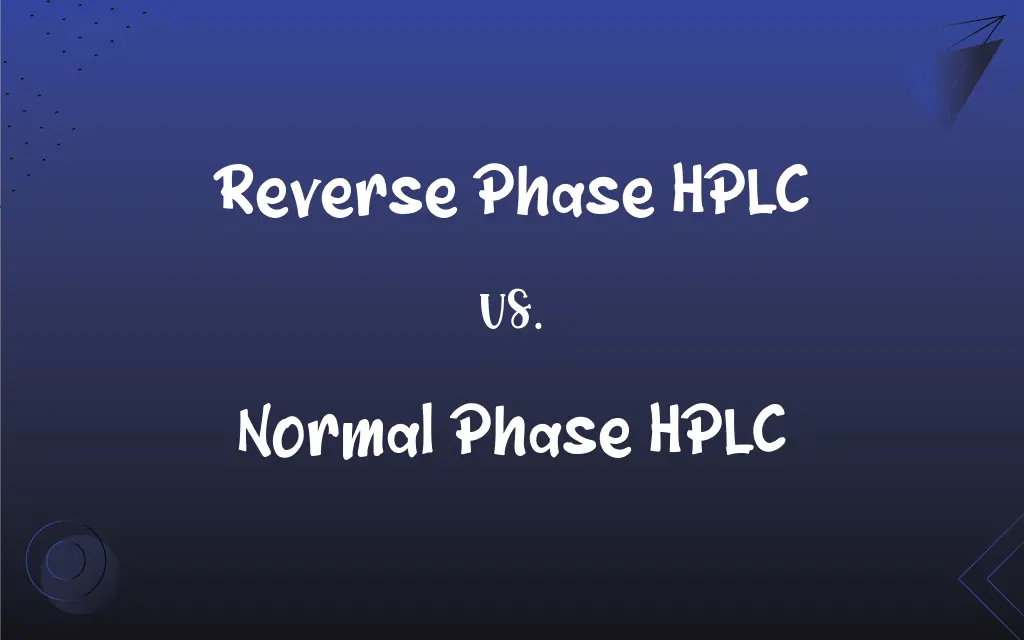Reverse Phase HPLC vs. Normal Phase HPLC: What's the Difference?
Edited by Aimie Carlson || By Janet White || Published on February 28, 2024
Reverse phase HPLC uses non-polar stationary phases for polar analytes separation, while normal phase HPLC uses polar stationary phases for non-polar analytes separation.

Key Differences
Reverse phase HPLC utilizes a non-polar stationary phase, typically silica modified with alkyl chains, suitable for separating polar compounds. In contrast, normal phase HPLC uses a polar stationary phase, like unmodified silica, for non-polar compound separation.
The mobile phase in reverse phase HPLC is more polar (like water or methanol), while in normal phase HPLC, it's less polar (like hexane or chloroform). This polarity difference drives the separation process in both techniques.
Reverse phase HPLC is effective for separating polar, hydrophilic molecules, whereas normal phase HPLC excels at separating non-polar, hydrophobic substances.
Reverse phase HPLC is widely used in pharmaceuticals and biotechnology for its versatility with polar compounds. Normal phase HPLC, though less common, is ideal for lipid, steroid, or other non-polar molecule analysis.
The key difference lies in the reversal of solvent polarity roles; reverse phase uses more polar solvents for non-polar stationary phases, whereas normal phase uses less polar solvents with polar stationary phases.
ADVERTISEMENT
Comparison Chart
Stationary Phase
Non-polar (e.g., alkyl-modified silica)
Polar (e.g., unmodified silica)
Mobile Phase
More polar (e.g., water, methanol)
Less polar (e.g., hexane, chloroform)
Target Analytes
Polar, hydrophilic compounds
Non-polar, hydrophobic compounds
Common Applications
Pharmaceuticals, biotech
Lipids, steroids analysis
Solvent Polarity
Reversed, uses polar solvents
Traditional, uses less polar solvents
ADVERTISEMENT
Reverse Phase HPLC and Normal Phase HPLC Definitions
Reverse Phase HPLC
Common in pharmaceutical and biotechnology applications.
Reverse phase HPLC is a staple in our drug analysis procedures.
Normal Phase HPLC
Suited for non-polar analytes.
We separated the non-polar compounds using normal phase HPLC.
Reverse Phase HPLC
Uses more polar solvents like water or methanol.
We used a water-methanol gradient in our reverse phase HPLC method.
Normal Phase HPLC
Employs less polar solvents like hexane.
Hexane was used as the mobile phase in our normal phase HPLC method.
Reverse Phase HPLC
Reverse phase HPLC separates compounds using a non-polar stationary phase.
In our lab, we use reverse phase HPLC for analyzing water-soluble vitamins.
Normal Phase HPLC
Based on hydrophilic interactions for compound separation.
Normal phase HPLC separated compounds based on their polarity.
Reverse Phase HPLC
Relies on hydrophobic interactions for separation.
The drug components were separated based on their hydrophobicity in reverse phase HPLC.
Normal Phase HPLC
Normal phase HPLC uses a polar stationary phase for separation.
Normal phase HPLC was employed to analyze the lipid content.
Reverse Phase HPLC
It's ideal for polar analytes.
Reverse phase HPLC effectively separated the polar compounds in the sample.
Normal Phase HPLC
Less common but essential for specific analyses.
For steroidal analysis, normal phase HPLC is preferred.
FAQs
What is reverse phase HPLC?
A HPLC technique using non-polar stationary phases for polar analytes.
What are common applications of reverse phase HPLC?
Pharmaceutical and biotechnological compound analysis.
What solvents are typical in normal phase HPLC?
Less polar solvents such as hexane and chloroform.
What is normal phase HPLC?
A HPLC method with polar stationary phases for non-polar analytes.
Is reverse phase HPLC suitable for polar or non-polar compounds?
It's best suited for polar compounds.
What type of stationary phase is used in reverse phase HPLC?
A non-polar, often alkyl-modified silica phase.
Which solvents are used in reverse phase HPLC?
More polar solvents like water and methanol.
Where is normal phase HPLC primarily used?
In the analysis of lipids, steroids, and other non-polar molecules.
What is the principle behind normal phase HPLC separation?
Separation based on hydrophilic interactions.
Are there any limitations to reverse phase HPLC?
It's less effective for very non-polar compounds.
What stationary phase is used in normal phase HPLC?
A polar stationary phase, like unmodified silica.
What are the limitations of normal phase HPLC?
It's less versatile compared to reverse phase HPLC, especially for polar analytes.
Can reverse phase HPLC handle a wide range of samples?
Yes, it's versatile and can handle diverse samples.
How does reverse phase HPLC separate compounds?
Through hydrophobic interactions between the analyte and the stationary phase.
Is reverse phase HPLC widely used?
Yes, it's the most common form of HPLC.
How prevalent is normal phase HPLC?
Less common, but important for specific applications.
Is normal phase HPLC suitable for complex mixtures?
It's effective but may require specific sample preparation.
What are the advantages of reverse phase HPLC?
High versatility, suitability for a wide range of polar compounds.
What advantages does normal phase HPLC offer?
Effective for separating non-polar compounds with high resolution.
Can normal phase HPLC analyze polar compounds effectively?
It's more effective for non-polar compounds.
About Author
Written by
Janet WhiteJanet White has been an esteemed writer and blogger for Difference Wiki. Holding a Master's degree in Science and Medical Journalism from the prestigious Boston University, she has consistently demonstrated her expertise and passion for her field. When she's not immersed in her work, Janet relishes her time exercising, delving into a good book, and cherishing moments with friends and family.
Edited by
Aimie CarlsonAimie Carlson, holding a master's degree in English literature, is a fervent English language enthusiast. She lends her writing talents to Difference Wiki, a prominent website that specializes in comparisons, offering readers insightful analyses that both captivate and inform.































































